Japanese
English
- 有料閲覧
- Abstract 文献概要
- 1ページ目 Look Inside
- 参考文献 Reference
要旨 H. pylori除菌治療が普及するにつれ,除菌後に発生する胃癌に対する対策が必要である.筆者らはCongo red色素内視鏡検査を用いて,萎縮性胃炎患者におけるH. pylori除菌前後の胃酸分泌領域の変化を検討し,除菌によって胃酸分泌領域の拡大することを認めた.しかし,除菌後数年を経過した時点でも非酸分泌領域が残存し,機能的に酸分泌が回復しない領域は,高い細胞増殖能を有し,除菌後胃癌の発生母地となる可能性を示していた.また,実際に発生した除菌後胃癌19病変はすべて非酸分泌領域から発生していた.非酸分泌領域の分布,大きさを確認することで,除菌後胃癌の好発部位,リスクを評価することが可能と考えられる.
Since there are sporadic cases of gastric cancer after successful eradication of Helicobacter pylori(H. pylori), careful follow-up with endoscopic examination for possible gastric cancer is necessary even for eradicated patients. Employing Congo red chromoendoscopy, we found that the area of the acid-secreting mucosa in the fundus was promptly expanded after eradication. However, in the subsequent long-term follow-up study using that technique, we also recognized that there were varying degrees of residual non-acid-secreting areas in the fundus in most cases, indicating incomplete recovery in terms of the regional acid-secreting capacity. Given that the non-acid-secreting area was characterized by sustained hyperproliferation, we hypothesized that such functionally irreversible mucosa could reflect increased malignant potential where new cancer could develop after eradication. Actually, we found that all 19gastric cancers emerging after H. pylori eradication arose exclusively from non-acid-secreting areas. Identification of such high risk areas might be a promising approach for estimating individual cancer risk after eradication.

Copyright © 2012, Igaku-Shoin Ltd. All rights reserved.


